Electrodeposition of Pd-Pt Nanocomposites on Porous GaN for Electrochemical Nitrite Sensing
Abstract
:1. Introduction
2. Experimental Section
3. Results and Discussion
4. Conclusion
Author Contributions
Funding
Conflicts of Interest
Abbreviations
| SEM | Scanning electron microscope |
| XRD | X-ray diffraction |
| EDS | Energy dispersive spectroscopy |
| CV | Cyclic voltammetry |
| CA | Chronoamperometry |
| EIS | Electrochemical impedance spectroscopy |
| PGaN | Porous gallium nitride |
| Pt/PGaN | Platinum-modified porous gallium nitride |
| Pd/PGaN | Palladium-modified porous gallium nitride |
| Pd-Pt/PGaN | Palladium and Platinum nanocomposites on porous gallium nitride |
| PECE | Photoassisted electrochemical etching |
| LOD | Limit of detection |
| UA | Uric acid |
| AA | Ascorbic acid |
| DA | Dopamine |
| GLU | Glucose |
References
- Bharath, G.; Madhu, R.; Chen, S.M.; Veeramani, V.; Mangalaraj, D.; Ponpandian, N. Solvent-free mechanochemical synthesis of graphene oxide and Fe3O4-reduced graphene oxide nanocomposites for sensitive detection of nitrite. J Mater. Chem. A 2015, 3, 15529–15539. [Google Scholar] [CrossRef]
- Wang, Z.; Fang, L.; Guo, T.; Yang, S.; Zeng, C. Synthesis of crystalline silver nanoplates and their application for detection of nitrite in foods. J. Electroanal. Chem. 2012, 664, 135–138. [Google Scholar] [CrossRef]
- Azad, U.P.; Turllapati, S.; Rastogi, P.K.; Ganesan, V. Tris (1,10-phenanthroline) iron (II)-bentonite film as efficient electrochemical sensing platform for nitrite determination. Electrochim. Acta 2014, 127, 193–199. [Google Scholar] [CrossRef]
- Li, X.; Kong, F.; Liu, J.; Liang, T.; Xu, J.; Chen, H. Synthesis of potassium-modified graphene and its application in nitrite-selective sensing. Adv. Funct. Mater. 2012, 22, 1981–1988. [Google Scholar] [CrossRef]
- Hallaj, R.; Salimi, A.; Kavosi, B.; Mansouri, G. Highly sensitive and ultra-selective amperometric nitrite sensor using cyclometalated Rh(III)-complex/CNTs modified glassy carbon electrode integrated with flow injection analysis. Sens. Actuators B Chem. 2016, 233, 107–119. [Google Scholar] [CrossRef]
- Broder, T.L.; Silvester, D.S.; Aldous, L.; Hardacre, C.A.; Compton, R.G. Electrochemical oxidation of nitrite and the oxidation and reduction of NO2 in the room temperature ionic liquid [C2mim] [NTf2]. J. Phys. Chem. B 2007, 111, 7778–7785. [Google Scholar] [CrossRef]
- Han, J.; Zhang, C.; Liu, F.; Liu, B.; Han, M.; Zou, W. Upconversion nanoparticles for ratiometric fluorescence detection of nitrite. Analyst 2014, 139, 3032–3038. [Google Scholar] [CrossRef]
- Tsikas, D.; Böhmer, A.; Mitschke, A. Gas chromatography-mass spectrometry analysis of nitrite in biological fluids without derivatization. Anal. Chem. 2010, 82, 5384–5390. [Google Scholar] [CrossRef]
- Hossein, A.-Z.; Elaheh, R. Utilizing of Ag@AgCl@graphene oxide@Fe3O4 nanocomposite as a magnetic plasmonic nanophotocatalyst in light-initiated H2O2 generation and chemiluminescence detection of nitrite. Talanta 2015, 144, 769–777. [Google Scholar]
- Afkhami, A.; Soltani-Felehgari, F.; Madrakian, T.; Ghaedi, H. Surface decoration of multi-walled carbon nanotubes modified carbon paste electrode with gold nanoparticles for electro-oxidation and sensitive determination of nitrite. Biosens. Bioelectron. 2014, 51, 379–385. [Google Scholar] [CrossRef]
- Govindhan, M.; Adhikari, B.-R.; Chen, A. Nanomaterials-based electrochemical detection of chemical contaminants. RSC Adv. 2014, 4, 63741–63760. [Google Scholar] [CrossRef]
- He, M.; Wu, W.; Yu, B.; Wu, H.; Wang, S.; Xia, Q. Nonenzymatic electrochemical sensor based on Fe@Pt core-shell nanoparticles for hydrogen peroxide, glucose and formaldehyde. Sens. Actuators B Chem. 2016, 223, 68–75. [Google Scholar]
- Rabti, A.; Ben Aoun, S.; Raouafi, N. A sensitive nitrite sensor using an electrode consisting of reduced graphene oxide functionalized with ferrocene. Microchim. Acta 2016, 183, 3111–3117. [Google Scholar] [CrossRef]
- Vilian, A.T.E.; Dinesh, B.; Muruganantham, R.; Sang, R.C.; Kang, S.M.; Yun, S.H.; Han, Y.K. A screen printed carbon electrode modified with an amino-functionalized metal organic framework of type MIL-101(Cr) and with palladium nanoparticles for voltammetric sensing of nitrite. Microchim. Acta 2017, 184, 4793–4801. [Google Scholar] [CrossRef]
- Santharaman, P.; Venkatesh, K.A.; Vairamani, K. Arm-microcontroller based portable nitrite electrochemical analyzer using cytochrome c reductase biofunctionalized onto screen printed carbon electrode. Biosens. Bioelectron. 2016, 90, 410–417. [Google Scholar] [CrossRef] [PubMed]
- Alifragis, Y.; Konstantinidis, G.; Georgakilas, A.; Chaniotakis, N. Anion selective potentiometric sensor based on gallium nitride crystalline membrane. Electroanalysis 2005, 17, 527–531. [Google Scholar] [CrossRef]
- Chen, C.Y.; Zhu, G.; Hu, Y.; Yu, J.W.; Song, J.; Cheng, K.Y.; Wang, Z.L. Gallium nitride nanowire based nanogenerators and light-emitting diodes. ACS Nano 2012, 6, 5687–5692. [Google Scholar] [CrossRef] [PubMed]
- Ambacher, O. Growth and applications of Group III-nitrides. J. Phys. D Appl. Phys. 1998, 31, 2653. [Google Scholar] [CrossRef]
- Zhao, Y.; Qin, S.; Li, Y.; Deng, F.; Liu, Y.; Pan, G.B. Electrodeposition of dendritic Pd nanoarchitectures on n-GaN (0001): Nucleation and electrocatalysis for direct formic acid fuel cells. Electrochim. Acta 2014, 145, 148–153. [Google Scholar] [CrossRef]
- Zhang, M.R.; Chen, X.Q.; Pan, G.B. Electrosynthesis of gold nanoparticles/porous GaN electrode for non-enzymatic hydrogen peroxide detection. Sens. Actuators B Chem. 2017, 240, 142–147. [Google Scholar] [CrossRef]
- Jiang, Q.M.; Zhang, M.R.; Luo, L.Q.; Pan, G.B. Electrosynthesis of bismuth nanodendrites/gallium nitride electrode for non-enzymatic hydrogen peroxide detection. Talanta 2017, 171, 250–254. [Google Scholar] [CrossRef]
- Mani, V.; Dinesh, B.; Chen, S.M.; Saraswathi, R. Direct electrochemistry of myoglobin at reduced graphene oxide-multiwalled carbon nanotubes-platinum nanoparticles nanocomposite and biosensing towards hydrogen peroxide and nitrite. Biosens. Bioelectron. 2014, 53, 420–427. [Google Scholar] [CrossRef] [PubMed]
- Yang, J.H.; Yang, H.; Liu, S.; Mao, L. Microwave-assisted synthesis graphite-supported Pd nanoparticles for detection of nitrite. Sens. Actuators B Chem. 2015, 220, 652–658. [Google Scholar] [CrossRef]
- Shahrokhian, S.; Rezaee, S. Vertically standing Cu2O nanosheets promoted flower-like PtPd nanostructures supported on reduced graphene oxide for methanol electro-oxidation. Electrochim. Acta 2018, 259, 36–47. [Google Scholar] [CrossRef]
- Zheng, J.; Wang, B.; Ding, A.; Bo, W.; Chen, J. Synthesis of MXene/DNA/Pd/Pt nanocomposite for sensitive detection of dopamine. J. Electroanal. Chem. 2018, 816, 189–194. [Google Scholar] [CrossRef]
- Bo, X.; Bai, J.; Yang, L.; Guo, L. The nanocomposite of PtPd nanoparticles/onion-like mesoporous carbon vesicle for nonenzymatic amperometric sensing of glucose. Sens. Actuators B Chem. 2011, 157, 662–668. [Google Scholar] [CrossRef]
- Zhang, M.R.; Qin, S.J.; Peng, H.D.; Pan, G.B. Porous GaN photoelectrode fabricated by photo-assisted electrochemical etching using ionic liquid as etchant. Mater. Lett. 2016, 182, 363–366. [Google Scholar] [CrossRef]
- Zhuang, D.; Edgar, J.H. Wet etching of GaN, AlN, and SiC: A review. Mater. Sci. Eng. 2005, 48, 1–46. [Google Scholar] [CrossRef]
- Jing, Z.; Ji, Y.; Dong, H.; Wang, W.; Chen, Z. Electrochemical determination of glucose using a platinum-palladium nanoparticle carbon nanofiber glassy carbon electrode. Analy. Lett. 2016, 49, 2741–2754. [Google Scholar]
- Datta, J.; Dutta, A.; Biswas, M. Enhancement of functional properties of PtPd nano catalyst in metal-polymer composite matrix: Application in direct ethanol fuel cell. Electrochem. Commun. 2012, 20, 56–59. [Google Scholar] [CrossRef]
- Yi, L.; Chi, M.; Mazumder, V.; More, K.L.; Soled, S.; Henao, J.D.; Sun, S. Composition-controlled synthesis of bimetallic PdPt nanoparticles and their electro-oxidation of methanol. Chem. Mater. 2011, 23, 4199–4203. [Google Scholar]
- Guo, S.; Dong, S.; Wang, E. Three-dimensional Pt-on-Pd bimetallic nanodendrites supported on graphene nanosheet: Facile synthesis and used as an advanced nanoelectrocatalyst for methanol oxidation. ACS Nano 2010, 4, 547–555. [Google Scholar] [CrossRef] [PubMed]
- Wang, P.; Li, F.; Huang, X.; Li, Y.; Wang, L. In situ electrodeposition of Pt nanoclusters on glassy carbon surface modified by monolayer choline film and their electrochemical applications. Electrochem. Commun. 2008, 10, 195–199. [Google Scholar] [CrossRef]
- Pham, X.H.; Li, C.A.; Han, K.N.; Huynh-Nguyen, B.C.; Le, T.H.; Ko, E. Electrochemical detection of nitrite using urchin-like palladium nanostructures on carbon nanotube thin film electrodes. Sens. Actuators B Chem. 2014, 193, 815–822. [Google Scholar] [CrossRef]
- Miao, P.; Shen, M.; Ning, L.M.; Chen, G.F.; Yin, Y.M. Functionalization of platinum nanoparticles for electrochemical detection of nitrite. Anal. Bioanal.Chem. 2011, 399, 2407–2411. [Google Scholar] [CrossRef] [PubMed]
- Wang, J.; Zhou, H.; Fan, D.; Zhao, D.; Xu, C. A glassy carbon electrode modified with nanoporous PdFe alloy for highly sensitive continuous determination of nitrite. Microchim. Acta 2015, 182, 1055–1061. [Google Scholar] [CrossRef]
- Yang, W.; Bai, Y.; Li, Y.; Sun, C. Amperometric nitrite sensor based on hemoglobin/colloidal gold nanoparticles immobilized on a glassy carbon electrode by a titania sol-gel film. Anal. Bioanal. Chem. 2005, 382, 44. [Google Scholar] [CrossRef]
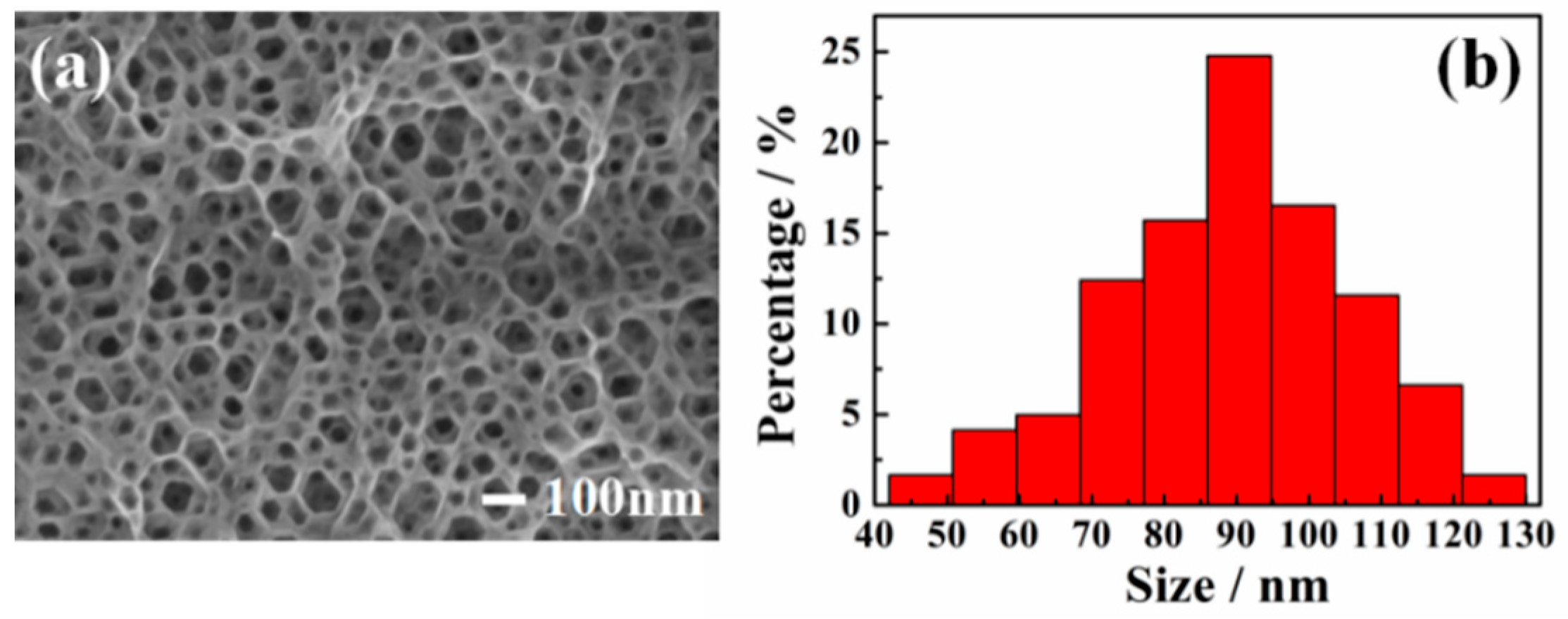
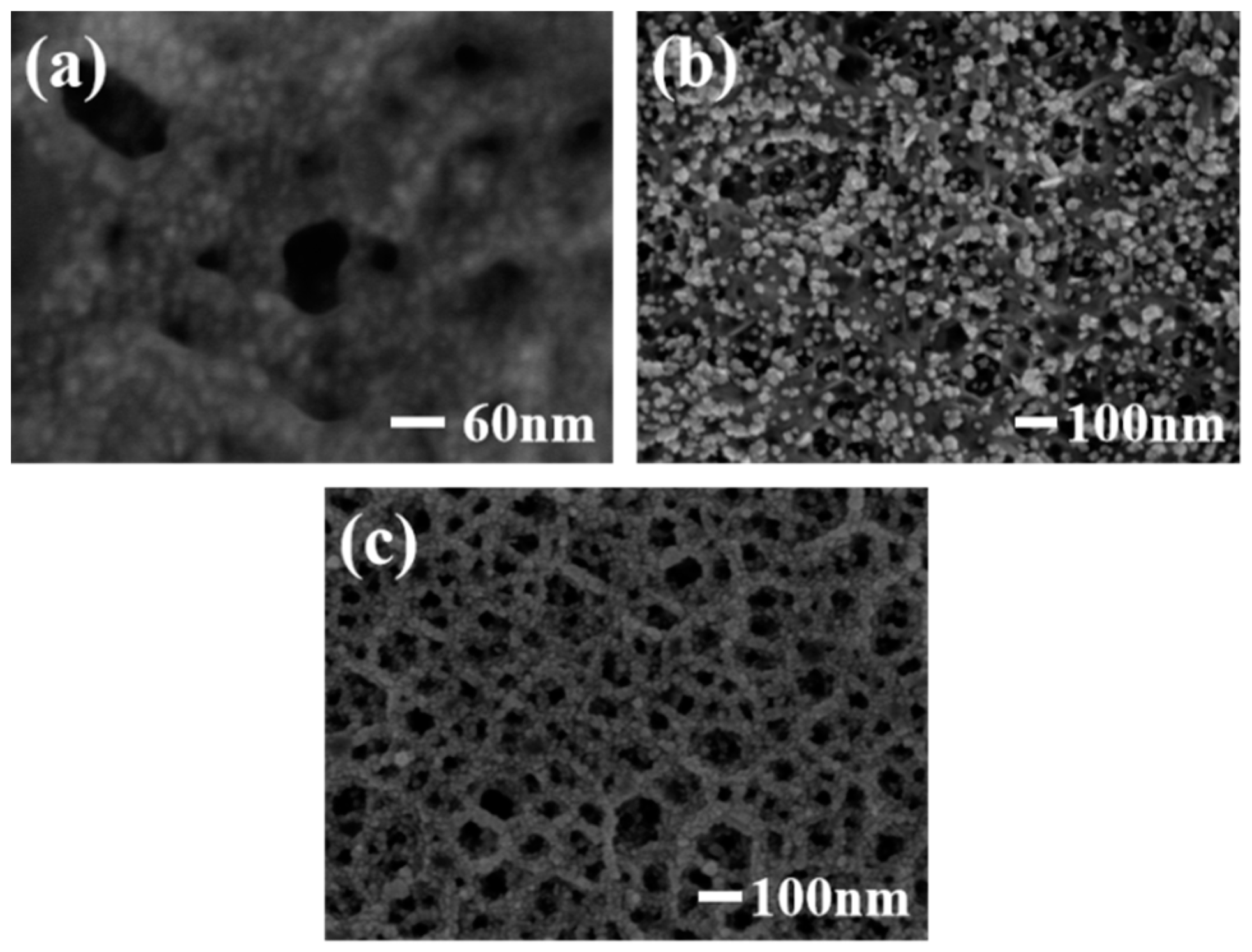

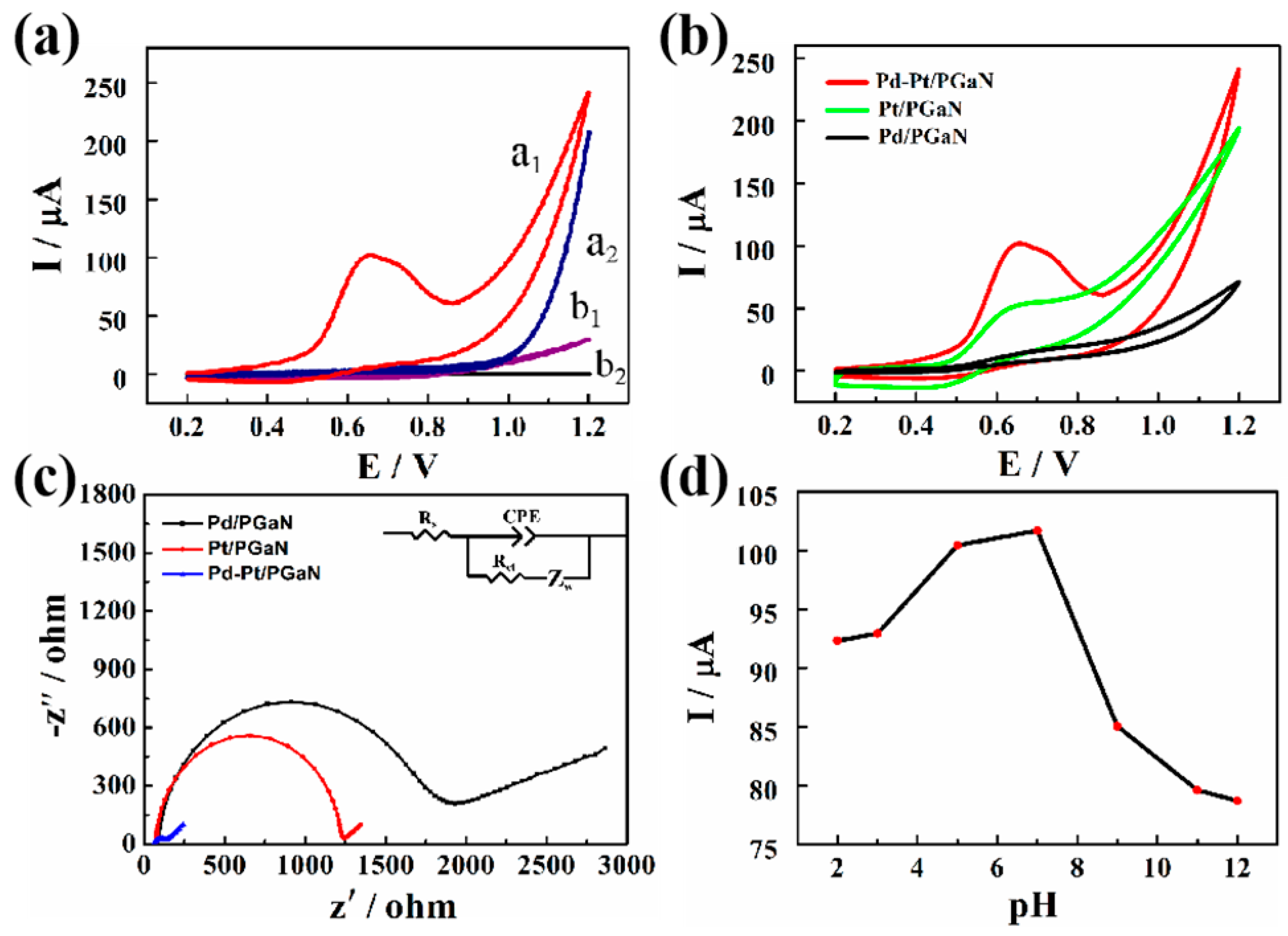
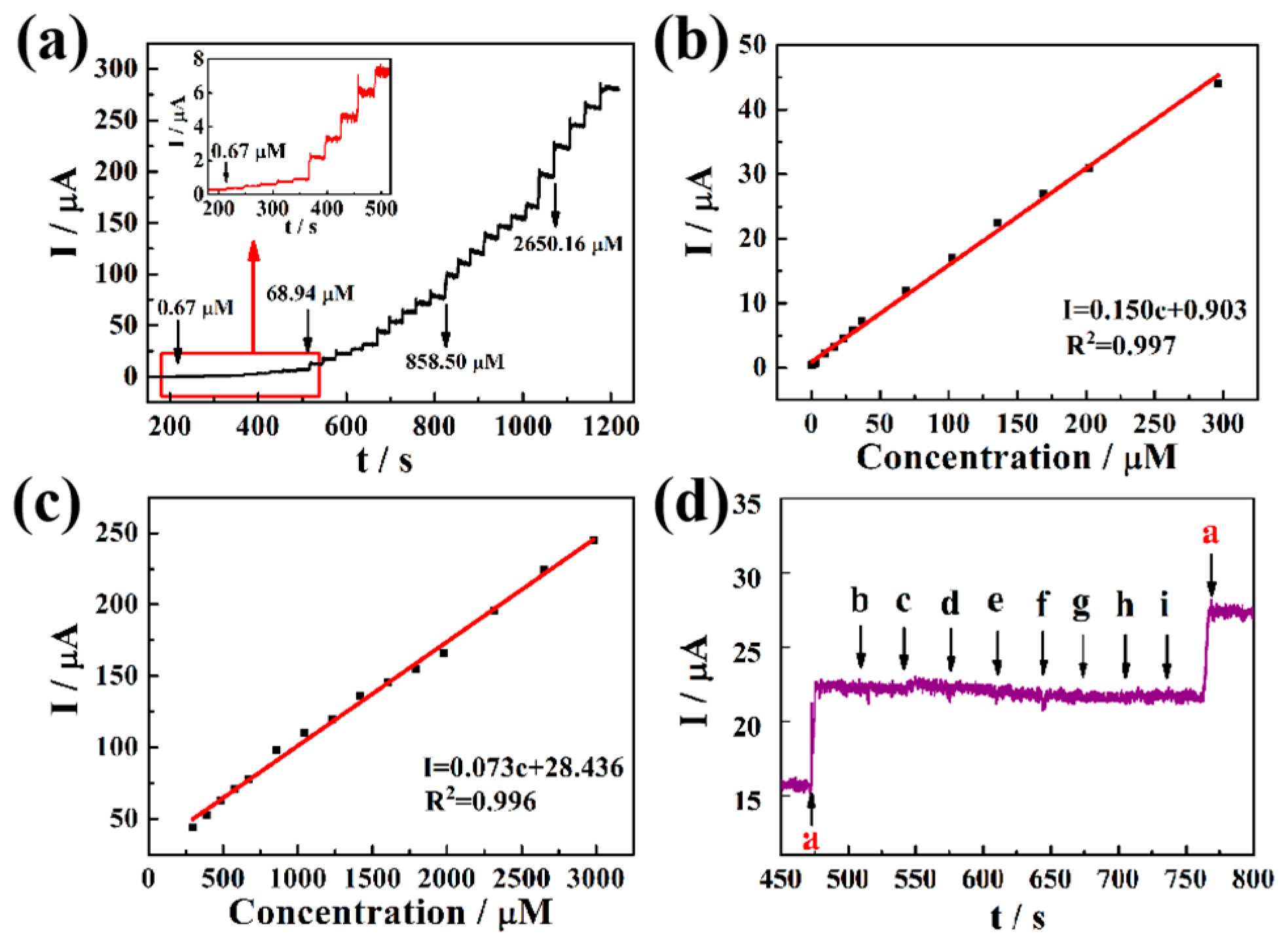
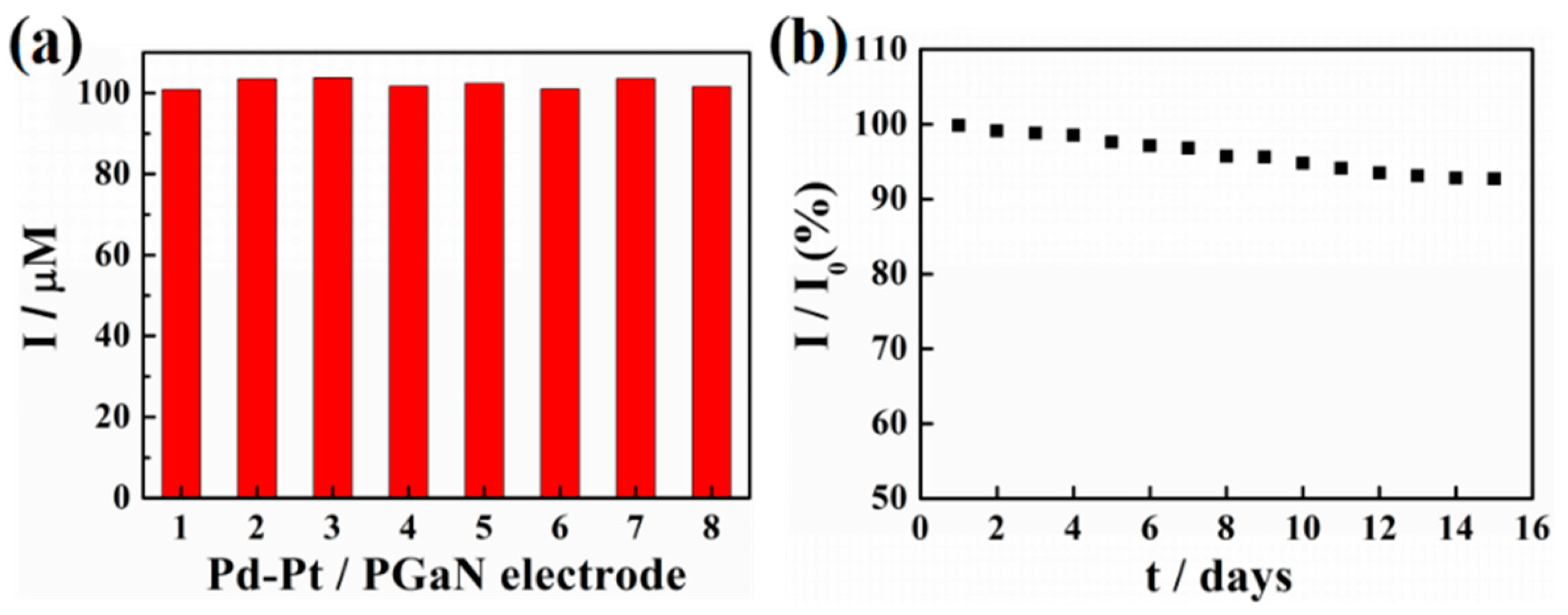
| Electrode | Sensitivity (µA/mM) | Linear Range (µM) | Detection Limit (µM) | Reference |
|---|---|---|---|---|
| Pt nanoparticles/GCE | 88.5 | 1.2–900 | 0.4 | [33] |
| Urchin-like Pd/SWCNT | 38 | 2–238 | 0.25 | [34] |
| Pd/graphite | 6.5 | 0.3–50.7 | 0.071 | [23] |
| Pt/Au | - | 10–1000 | 5.0 | [35] |
| PdFe alloy/GCE | - | 500–25500 | 0.8 | [36] |
| Hb/Au/GCE | - | 4–350 | 1.2 | [37] |
| Pd-Pt/PGaN | 150 73 | 1–300 300–3000 | 0.95 | This work |
| Sample | Theoretical (µM) | Found (µM) | Recovery (%) | R.S.D (%) |
|---|---|---|---|---|
| 20.0 | 21.2 | 106.0 | 2.8 | |
| Tap water | 40.0 | 38.92 | 97.3 | 3.1 |
| 60.0 | 61.43 | 102.4 | 2.9 | |
| 20.0 | 19.52 | 97.6 | 2.6 | |
| Lake water | 40.0 | 38.46 | 96.2 | 3.2 |
| 60.0 | 62.63 | 104.4 | 3.5 |
© 2019 by the authors. Licensee MDPI, Basel, Switzerland. This article is an open access article distributed under the terms and conditions of the Creative Commons Attribution (CC BY) license (http://creativecommons.org/licenses/by/4.0/).
Share and Cite
Xi, R.; Zhang, S.-H.; Zhang, L.; Wang, C.; Wang, L.-J.; Yan, J.-H.; Pan, G.-B. Electrodeposition of Pd-Pt Nanocomposites on Porous GaN for Electrochemical Nitrite Sensing. Sensors 2019, 19, 606. https://doi.org/10.3390/s19030606
Xi R, Zhang S-H, Zhang L, Wang C, Wang L-J, Yan J-H, Pan G-B. Electrodeposition of Pd-Pt Nanocomposites on Porous GaN for Electrochemical Nitrite Sensing. Sensors. 2019; 19(3):606. https://doi.org/10.3390/s19030606
Chicago/Turabian StyleXi, Rui, Shao-Hui Zhang, Long Zhang, Chao Wang, Lu-Jia Wang, Jing-Hui Yan, and Ge-Bo Pan. 2019. "Electrodeposition of Pd-Pt Nanocomposites on Porous GaN for Electrochemical Nitrite Sensing" Sensors 19, no. 3: 606. https://doi.org/10.3390/s19030606
APA StyleXi, R., Zhang, S.-H., Zhang, L., Wang, C., Wang, L.-J., Yan, J.-H., & Pan, G.-B. (2019). Electrodeposition of Pd-Pt Nanocomposites on Porous GaN for Electrochemical Nitrite Sensing. Sensors, 19(3), 606. https://doi.org/10.3390/s19030606




